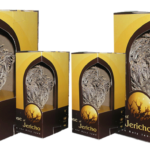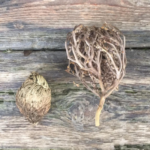The real Rose of Jericho
Mystical Easter Rose of Jericho
The Rose of Jericho, also known as the resurrection plant or Real rose of Jericho anastatica hierochuntica is a fascinating plant that has been used for centuries for its alleged mystical properties. Its origins can be traced back to the deserts of the Middle East, particularly in the city of Jericho in Israel, from which it derives its name.
In Christianity, the Rose of Jericho holds great significance, particularly in the Easter season. The plant is believed to symbolize the resurrection of Jesus Christ, with its ability to seemingly die and come back to life. It is said that the plant can survive for years without water, but when placed in a bowl of water, it will open up and come back to life, just as Jesus rose from the dead.
There are several references to the Rose of Jericho in the Bible, particularly in the Old Testament. For instance, in the Book of Hosea, it is mentioned that God will revive his people like the Rose of Jericho: “I will be like the dew to Israel; he shall blossom like the lily; he shall take root like the trees of Lebanon; his shoots shall spread out; his beauty shall be like the olive, and his fragrance like Lebanon. They shall return and dwell beneath my shadow; they shall flourish like the grain; they shall blossom like the Rose of Jericho” (Hosea 14:5-7).
Similarly, in the Book of Isaiah, the Rose of Jericho is used to describe God’s power to revive his people: “For I will pour water on the thirsty land, and streams on the dry ground; I will pour my Spirit upon your offspring, and my blessing on your descendants. They shall spring up among the grass like willows by flowing streams. This one will say, ‘I am the Lord’s,’ another will call on the name of Jacob, and another will write on his hand, ‘The Lord’s,’ and name himself by the name of Israel. Thus says the Lord, the King of Israel and his Redeemer, the Lord of hosts: ‘I am the first and I am the last; besides me there is no god’” (Isaiah 44:3-6).
The Christian heritage of the Dimoshis, a community in Egypt, also has a strong connection to the Rose of Jericho. The Dimoshis are known for their reverence for the plant and their belief in its mystical properties. They use it in their religious ceremonies, particularly during the Holy Week leading up to Easter.

According to their tradition, the Rose of Jericho was brought to Egypt by the Holy Family when they fled from King Herod’s persecution. The plant is said to have sustained them during their journey through the desert and was a symbol of God’s miraculous protection.
Today, the Dimoshis continue to use the Rose of Jericho in their religious rituals, such as the washing of the feet ceremony during Holy Week. They believe that the plant can bring healing, prosperity, and protection to those who use it with faith.
The Rose of Jericho is a plant with a rich history and symbolism in Christianity. Its ability to seemingly come back to life after being dormant for years is seen as a symbol of resurrection and God’s power to revive his people. The plant’s significance is also deeply rooted in the Christian heritage of the Dimoshis in Egypt, where it is used in their religious ceremonies and revered as a symbol of God’s protection and miraculous provision.





